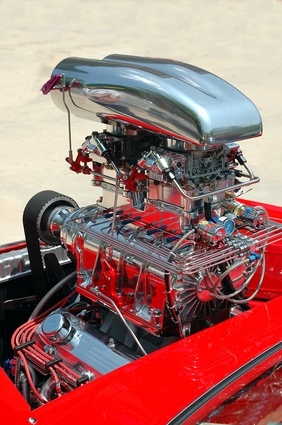
Holley carburetors are a popular choice for car enthusiasts interested in improving the performance of their vehicles. Holley has been making carburetors for more than 100 years. The Holley name is one of the most recognizable performance brands in automotive racing. Holley carburetors perform well as manufactured, but different engines require careful selection and tuning of the right Holley carburetor to produce their full potential.
The size of the carburetor to be used on a particular engine is determined by the displacement of the engine and its intended RPM range. Determining the proper carburetor size is done by multiplying the engines displacement by its maximum intended RPM. The resulting number is then divided by 3,456 and gives the approximate size for the carburetor. To choose the carburetor using this number, you select the carburetor that comes closest to the number without going under it. It is preferable to choose a carburetor slightly larger than the number, as a smaller carburetor may starve the engine for fuel and air -- thereby reducing the engine's maximum power output.
Older Holley carburetors used cork and paper gaskets that shrink with age and can tear apart when the carburetor is dismantled. Holley produces blue gaskets made of much stronger materials that resist sticking, tearing and shrinking and can be reused when servicing the carburetor.
The accelerator pump on Holley carburetors is controlled by a nylon cam attached to the throttle assembly. The amount of fuel sprayed into the carburetor by the accelerator pump can be adjusted by changing the cam out with one of several different sized cams provided in kits by Holley. Changing the accelerator pump cam can help to improve throttle response and correct problems with hesitation or stalling.
A vacuum-operated secondary on Holley carburetors uses a spring to control the rate of opening. Adjusting the opening rate requires that you open the diaphragm housing to change the spring. The rubber diaphragm often tears upon reassembly of the diaphragm housing. To avoid tearing and simplify the process. Holley offers a quick-change kit that allows you to replace the spring without removing the diaphragm.
Fuel-metering jets regulate the rate and amount of fuel that flows into the float bowls. Determining the proper jet sizes is done through trial and error until the best performing sizes are found. Jets that are too small will cause the engine to hesitate or stumble upon acceleration. Jets that are too large will cause the engine to bog down and emit black smoke from the exhaust, often accompanied by the smell of unburned fuel. The proper jet size helps the engine to produce responsive acceleration without smoke coming from the exhaust.
Holley carburetors require specific fuel levels be maintained in the float bowls to avoid problems with stalling upon acceleration and deceleration. Fuel levels in the float bowls should be adjusted so that the fuel barely dribbles out of the sight plugs on the sides of the fuel bowls, when the car is gently rocked by pushing on the fender.